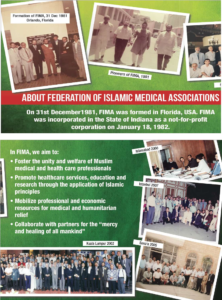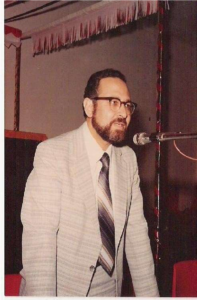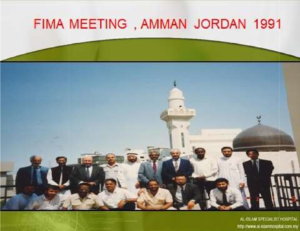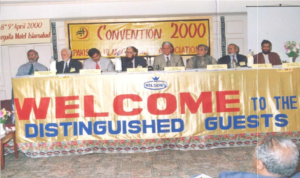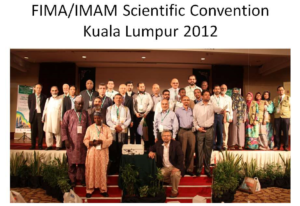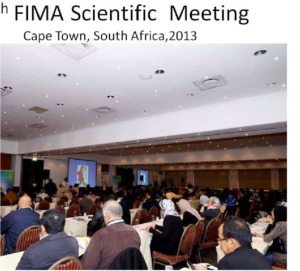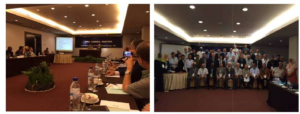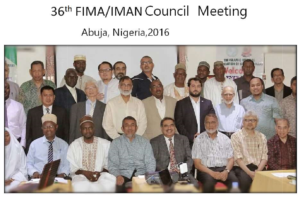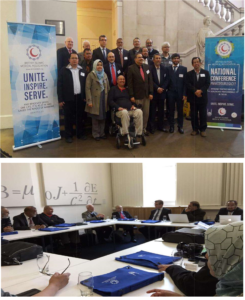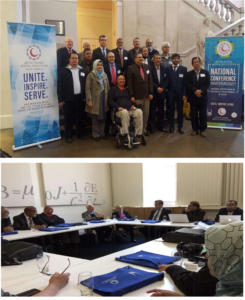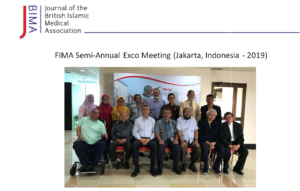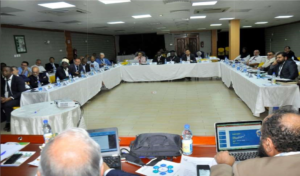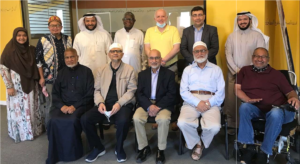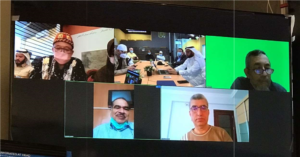
Introduction
The Federation of Islamic Medical Associations (FIMA) was founded in a meeting on the 31st of December in 1981 (1) in Orlando, Florida, the United States of America. Thirteen doctors from ten countries (Canada, India, Indonesia, Jordan, Nigeria, the United States, Pakistan, Saudi Arabia, Sudan, and the United Kingdom) were at the inaugural meeting. During the inaugural meeting Dr. Syed Mubin Akhtar from Pakistan was elected as the first President of FIMA. Subsequently, FIMA was incorporated in the State of Indiana as a not- for- profit corporation on the 31st of January 1982. FIMA has been awarded Tax Exemption Status under section 501 (C)(3) from the US Federal Income Tax by the Internal Revenue Service. At the end of this article we will see a few pictures of previous FIMA meetings that have taken place over the last 40 years.
FIMA (2) was founded on the following objectives:
- To foster the unity of Muslim medical and healthcare professionals
- To promote healthcare services, education, and research through the application of Islamic principles
- To mobilize professional and economic resources for medical and humanitarian relief
- To collaborate with partners for the ‘mercy and healing of all mankind”
Membership
Starting with healthcare professionals from 10 member countries, FIMA now spans 43 countries globally with 53 associations as its full and associate members with more than 100,000 members and volunteers. The catalyst towards the formation of FIMA was the Islamic Medical Association of North America (IMANA) (3) which was established in 1967 in Newark New
Jersey. The pioneering founder of IMANA who spearheaded the formation of FIMA was the late Dr. Ahmad El Kadi (4) who passed away in 2009. Besides IMANA, other pioneering Islamic Medical Association (IMA) which joined FIMA in the embryonic years were IMA Pakistan (5) (PIMA established in 1979) South Africa (6) (IMASA established in 1981), Islamic Doctors Forum of Indonesia (FOKI, established in 1981), Islamic Hospital Jordan (7) (established in 1982), IMA Sudan (SIMA established in 1983). In the first 10 years of its formation the following IMAs became members of FIMA; IMA Malaysia (8) (IMAM established in 1990, joined FIMA in 1991), IMA Yemen (9) (registered as Yemen Medical Charitable Society or YMCS (established 1991 and joined FIMA the same year). In the second decade of its formation, FIMA showed a steady growth in its membership coming from Europe (Arab Doctors in Europe or Arabmed joined in 1994) (10), IMA Uganda (11) (IMAU established 1988 joined in 1994), Turkey (Hayat Foundation established in 1988 joined in 1996, IMA Saudi Arabia (IMAKSA established in 1996 joined in 1996), IMA Lebanon (IMALB established in 1982 joined in 1996), IMA Algeria (joined in 2000), IMA Bangladesh (National Doctors Forum established in 1989 joined in 2000)
The third decade of its formation showed an influx in new members to FIMA namely IMA Cambodia (IMAC established in 2001 joined in 2004), IMA Indonesia (12) (IMANI joined in 2004), IMA Iraq (Al Razi Medical Society joined in 2006), IMA Somalia (IMA Som established in 2006 joined in 2007), Young Doctors of Somalia (SOYDA established in 2007 joined in 2009), IMA Kenya (KAMMP established in 1998 joined in 2010), IMA Zimbabwe (IMAZ established in 2006 joined in 2010), IMA Queensland (IMAQ established in 2020 joined in 2020), IMA Nigeria (IMAN established in 1989 joined in 2011), IMA Palestine (Emergency and Welfare Society established in 1992 joined in 2011), IMA Thailand (TIMA established in 2003 in joined 2011).
This last decade showed more IMAs joining the FIMA fraternity namely IMA Afghanistan (AIMA established in 2008 joined in 2012), IMA India (IMAI established in 2010 joined in 2012), IMA Gaza (Palestinian Medical Forum joined in 2012), IMA Sri Lanka (Serendib Doctors Forum joined in 2012), IMA Tunisia (Association of United Doctors for Tunisia established in 2012 joined in 2013), IMA Britain (13) (BIMA UK established in 2013 joined in 2015), IMA Singapore (Muslim Professional Health Association established in 2004 joined in 2015), IMA Philippines (Bangsamoro Medical Society established in 2009 joined in 2015), IMA Morocco (joined in 2015), IMA Niger (AMIN joined in 2016), IMA Ghana (Muslim Health Workers Association established in 2015 joined in 2017), Medical Relief Agency of Malaysia (MRA established in 2010 joined in 2017), Al Khidmat Pakistan (14) (established in 1990 joined in 2017), IMA Somaliland (established in 2004 joined in 2017), IMA Tanzania (Sunshine Medical Volunteers established in 2010 joined in 2017), IMA Malawi (IHAM established in 2015 joined in 2019), Medics World Wide (established in 2016 joined in 2019), Union of Egyptian Medical Professional (UEMP established in 2017 joined in 2019), Kibuli Hospital Uganda (joined 2019) and last year (2021) two more IMAs were admitted to FIMA namely IMA Australia (AIMA established 2016) and IMA Canada (Muslim Medical Association of Canada established 2021)
FIMA now has members from 43 countries covering 5 continents. Besides IMAs of these countries (full members), there are also members from relief organizations (3) and hospitals (425 in total), and universities (38) admitted as associate members. FIMA now has among its membership more than 100,000 health care professionals and volunteers, the largest membership being from SIMA with 16,743 members followed by IMAN with 15,000 members and IMANA with 7,000 members. As regards Relief organization, Al Khidmat of Pakistan has 25,000 volunteers in its rank
Organisational Structure
The affairs of FIMA are guided by its constitution and bye laws.
The FIMA Council is the highest policy making body of FIMA. The Council consists of one representative from each member organization who attends the yearly FIMA Council Meeting. The day to day running of FIMA is managed by an Executive Committee which comprises of 9 members. Seven members are elected bi-annually during alternate Council meetings, namely the President, Vice President, Secretary, Treasurer and three committee members. These 7 elected members are joined by the immediate Past President, and an Executive Director making up for a nine member Executive Committee or in brief EXCO. The EXCO meets physically at least 3 times a year. Since 1981, thirteen Presidents have been elected from 8 different countries (Pakistan, South Africa, Egypt, Sudan, the United States of America, Jordan, Malaysia, and Turkey).
Besides the EXCO, FIMA is also guided by a 12 member Advisory Council which comprises of Past Presidents, recipients of FIMA Lifetime Achievement Awards and senior members who have made major contributions towards FIMA. The Advisory Council plays an advisory role with no voting rights. The 12 member Council is chaired by a chairman from among them who are invited to attend FIMA EXCO meeting.
Since its inception in 1981, the Council has met 38 times. Beginning from 1987, the Council meets every year and so far, 17 countries have hosted the Council Meeting (USA, South Africa, Tanzania, Sudan, Nigeria, Morocco, Uganda, France, Egypt, Bosnia, Turkey, Lebanon, Jordan, Yemen, Pakistan, Malaysia, Indonesia). Indonesia has hosted 5 FIMA Council meetings, followed by Malaysia and Jordan who have hosted 4 meetings each. Each yearly Council meeting is followed by 2 to 3 days of a Scientific Conference organized in conjunction with the host country. Even during the challenging years of the COVID 19 Pandemic FIMA yearly Council and Scientific Conference were held, virtually.
FIMA Projects
The heartbeat of FIMA is the activism of its IMAs. Besides national level program organized by the various IMAs, the objectives of FIMA listed above are externalized through the various projects which the Council approved over the last 3 decades. The various projects and year of implementation are as follows
- FIMA Relief 1994
- FIMA Students Activities 1999
- Consortium of Islamic Medical Colleges (CIMCO) 2000
- Islamic Hospital Consortium (IHC) 2000
- FIMA Yearbook 2002
- FIMA HIV/AIDS Resource Centre 2004
- FIMA Save Vision 2005
- FIMA Save Smile 2008 FIMA Save Dignity 2009
- FIMA Encyclopedia 2010
- FIMA Addiction Group 2013
- FIMA Life Saver 2017
- FIMA Journal 2017
- FIMA Save Water 2017
- FIMA Surgical Training 2019
- FIMA Save Earth 2021
The various projects approved by the Council have made significant contributions in tandem with FIMA’s objective “for the mercy and healing of all mankind”. These FIMA projects also directly and indirectly contribute to the United Nation Sustainable Develop Goals Particularly Goal 3 (Good Health and Well Being), Goal 4 (Quality Education), Goal 6 (Clean Water and Sanitation), Goal 10 (Reduce inequalities), Goal 12 (Responsible Consumption and Production) and Goal 13 (Climate Action). Each of the FIMA projects is headed by a chairman who coordinates activities with other IMAs. Every six months, a chair of each project will present their activities to the EXCO and to the annual Council meeting. Major achievements of some of the projects are summarized below
FIMA Relief
Humanitarian relief has been the flagship FIMA activity since its inception. It is the first project from the Council, first mooted in 1991 and approved in 1994 in the 11th Council Meeting in Paris. FIMA has since then declared itself as a medical manpower provider. The objectives of FIMA Relief include:
- to coordinate relief activities of different IMA’s
- to invite like-minded NGOs to participate in different relief activities organized by FIMA
- to seek cooperation with International Relief Organizations
- to prepare a database of international volunteers
Among the activities of FIMA SAC is the organisation of student camps held yearly since 1999. These camps are held in several member countries including Jordan (1999, 2013), Saudi Arabia (2000 and 2001), Lebanon (2004), Malaysia (2005, 2009), Egypt (2006, 2010), Indonesia (2007, 2008, 2011, 2015), Turkey (2012, 2017) and Uganda (2019). Besides the yearly camps, yearly Umrah programmes were also organised with the following objectives:
- To foster brotherhood among Muslim students from various IMAs.
- To enhance mutual understanding and cooperation.
- To exchange information and experiences.
- To provide leadership training and organizational skills.
- To strengthen the involvement of students in IMA activities.
- To promote communication and networking among the student chapters of IMAs and other countries.
FIMA Model of Humanitarian Relief
Prompt and effective communication forms the backbone of the FIMA relief model. Following the recognition of a disaster, a local relief coordinator is appointed to coordinate and facilitate humanitarian aid and medical relief missions in that region.
The local team is commissioned to conduct a rapid needs assessment based on local conditions and needs. The local coordinator in collaboration with the FIMA Relief coordinator establishes and formulates a holistic multidisciplinary response involving the broader network of relief coordinators and their partnerships with humanitarian relief organizations.
The progress and development of the disaster is monitored with regular updates and communication between all partners. At every stage in the life-cycle of the disaster and audit/evaluation of the impact of our intervention is assessed. This ultimately results in a final report with accountability and acknowledgement of aid received. Regular training in disaster mitigation, preparedness and response is conducted with every council meeting.
Over the last 2 decades FIMA Relief has been involved in the following relief activities in disaster areas
- Afghanistan war (7 October 2001: war on terror)
- Bam earthquake, Iran (Silk Road, Iran, 23 December 2003)
- Aceh Earthquake and Tsunami (26 December 2004, Aceh Indonesia)
- Darfur, Sudan (medical missions established)
- Pakistan Earthquake (8 October 2005, Azad Khashmir)
- Jogyakarta Earthquake (27 May 2006)
- Japanese Earthquake (11 March 2011)
- Libya revolt (February 2011)
- Egyptian Revolt
- Somalia civil unrest (SOYDA
- Pakistani Floods (Quetta, Pakistan: Mother and child mobile)
- Lebanon (Palestinian refugee camps, September 2010)
- Philippines Typhoon Haiyan and Floods (8 November 2013)
- Gaza (7 July 2014, Operation Protective Edge)
- Gaza (ongoing)
- Yemen relief (ongoing)
- Lebanon Blast (4 August 2020)
- Rohingya Refugee Camp (ongoing) This project is headed by IMA South Africa (IMASA)
FIMA Student Activities
Launched in 1999, FIMA Student Activities was established with following objectives
- To foster brotherhood among Muslim students of various IMAs
- To enhance mutual understanding and cooperation.
- To exchange information and experiences.
- To provide leadership training and organizational skills.
- To strengthen the involvement of students in IMA activities.
- To promote communication and networking among the student chapters of IMAs and other countries.
Among the activities of FIMA SAC is the organisation of students’ camps held yearly since 1999.These camps are held in several member countries including Jordan (1999, 2013), Saudi Arabia (2000 and 2001), Lebanon (2004), Malaysia (2005, 2009), Egypt (2006, 2010), Indonesia (2007, 2008, 2011, 2015), Turkey (2012, 2017) and Uganda (2019). Besides the yearly camps, yearly Umrah programmes were also organised with the following outline
- Directed and guided Umrah and visit to the Holy mosques in Makkah and Al madinah.
- Visits to Islamic historic and famous relic places
- Lectures, roundtable discussions, workshops & Seminars
- Project presentation
- Meetings and visits
- Spiritual sessions
- Cultural show
- Outdoor activities and sports
- Educational tour
The success of these students’ activities is closely attributed to the coordination by IMA Kingdom of Saudi Arabia and the World Assembly of Muslim Youth (WAMY)
FIMA IHC
The Islamic Hospital Consortium was a project approved by the Council in 2000. It was created for the following objectives
- Islamisation of Health services
- Sharing the concept of hospital as a platform of Dakwah
- Understanding and application of Maqasid Shariyyah (The Purpose of Islamic Shariah) and the Qawaid al Fiqhiyah (Principles of Islamic Jurisprudence) in medicines
- Application and Implementation of Concept of Shariah Compliant Hospital
- Sharing and Application of the concept of Ibadah Friendly Hospital
- Establishment of Spiritual Support Care Program in hospital
Activities from this consortium have been escalated following publications of Guidebooks and Manual on the practical implementation of both the Shariah Compliant and Ibadah Friendly Hospitals from Pakistan, Malaysia, and Indonesia. Workshops and seminars continued to be organized and interest has come from both Muslim majority and Muslim minority countries (the Philippines and United Kingdom)
This project is headed by IMA Malaysia (IMAM)
FIMA Yearbook
Since 2002, FIMA has produced a repository of Islamic oriented publications called the FIMA Yearbook. This is in tandem with one of the FIMA objectives “to promote healthcare services, education and research through the application of Islamic principles”. This project was spearheaded by the late Dr. Aly Mishal of Jordan and now under the Dr. Musa Mohammad Nordin. The first publication was in 2002 with the theme Contemporary Bio Medical Issues in the Light of Islam (2002). Since 2012, the publication became a yearly affair with the following themes; Health in The Muslim World; Meeting the Millennium Development Goal (2012), Encyclopedia of Islamic Medical Ethics Part I (2013) Addiction:
Medical, Psychosocial and Islamic Perspectives (2014),
Encyclopedia of Islamic Medical Ethics Part II (2015),
Encyclopedia of Islamic Medical Ethics Part III (2016),
Encyclopedia of Islamic Medical Ethics IV (2017),
Encyclopedia of Islamic Medical Ethics Part V (2018),
Encyclopedia of Islamic Medical Ethics Part VI (2019),
Encyclopedia of Islamic Medical Ethics Part VII (2020).
The FIMA Yearbook has been instrumental in providing high quality resources. Soft copies of the Yearbook can be accesses at the following site
https://fimaweb.net/category/publications/yearbook/.
Limited hard copies have been distributed to member countries and distributed to libraries of various universities. This project is headed by IMA Malaysia (IMAM).
FIMA Save Vision (FSV)
This project is sometimes referred to as the ‘Jewel in the Crown ‘of FIMA activism. Approved by the Council in 2005 FSV had a vison which states A world in which no one is needlessly blind and where those with avoidable blindness can achieve the full potential and the Mission to work for the elimination of the avoidable causes of blindness regardless of religion, ethnicity, gender, and nationality. Since its establishment FSV has performed 145,700 cataract surgeries in 20 countries mainly in Sub Saharan Africa. It was fitting that FSV was awarded the Prestigious American College of Physician Hilda and Rosenthal Award for 2008. In the award plaque, FSV contribution is stated as whose recent original approach in the delivery of health care or in the design of facilities for its delivery will increase its clinical and /or economic effectiveness
This unique project not only served patients’ unmet needs, it also equally if not more importantly contributed to human resource development. FSV in collaboration with Hergesia University of Somaliland, Peshawar Medical College of Pakistan and Riphah International University of Pakistan and Manhal Charitable Hospital of Hergesiahas trained 17 doctors to the level of Clinical Diploma of Ophthalmology. The training program has moved on with the establishment of a Master of Science in Ophthalmology with two having completed their training and two more being trained. FSV also endeavour to establish sustainable facilities called FIMA Eye Centres in at least 3 countries, Sudan, Sri Lanka, and Pakistan.
This project is headed by IMA Pakistan (PIMA)
The International Journal of Human and Health Sciences (IJHHS)
This is a more recent FIMA project approved at the Council meeting in 2017. The impetus for the journal is triggered by the success of FIMA Yearbooks and the need for more academic and scientific exchanges between FIMA members and institutions they represent. It is also the natural progression following the established of the Consortium of Islamic Colleges (CIMCO). Following its approval by the Council it started as a semi-annual journal but in the year 2018 it became a quarterly journal. With the grace of Allah 20 issues including 3 supplementary issues containing 259 articles from various FIMA member countries have been published. Despite being a new initiative, IJHHS is already included and indexed in the Cross Ref, Index Copernicus, Euro-Pub, DOAJ., HINARI (WHO), EBSCO Library (USA). Alhamdulillah IJHHS is in active consideration for listing under the ‘Web of Science’ (WOS) with Harzing’s Citation index showing increasing Citation number.
Thus, the project is headed by IMA Bangladesh (National Doctors Forum) and IMA Indonesia (IIMA)
International Collaboration
FIMA is involved with many international bodies including the United Nations, World Health Organisation, Organisation of Islamic Cooperation. At the United Nation General Assembly FIMA contributes directly to the Economic and Social Council (ECOSOC) by submitting 5 yearly reports on its activities.
FIMA has been working with WHO-EMRO (Eastern Mediterranean Regional Office) in the Polio Eradication Initiative (PEI- Polio) since 2013. FIMA is a standing member of the International Islamic advisory group on eradication of Polio and communicable disease. FIMA also has a advisory status with the Science and Technology wing of Organization of Islamic cooperation and its subsidiary SESRIC (Social and economic and statistical research institute.)
The future
As a unique federation, FIMA has the potential to leverage its current and previous achievements. The current COVID 19 pandemic though challenging to FIMA has brought out the best out of FIMA in terms of its advocacy role to the Muslim population in particular. FIMA in collaboration with its member IMA’s developed ways and means to help fight the menace of the pandemic. Standard Operating Procedures (SOP’s) were developed to address challenging issues like praying in the mosques, religious holidays assemblies, burials of the dead within Muslim traditions, provision of medical services, supplying Personal Protective Equipment’s (PPEs) to medical facilities and establishment of laboratories for diagnostic purposes. The world in general and FIMA in particular will be better prepare in sha Allah in future should such a global health challenge occurs
Within FIMA, there is a disparity among IMAs with some well ahead and others in the infancy needing assistance to realise their full potentials. The world when FIMA was born is different from that of this millennium, it is Within FIMA, there is a disparity among IMAs with some well ahead and others in the infancy needing assistance to realise their full potentials. The world when FIMA was born is different from that of this millennium, it is important that FIMA moves with the times and identifies new stakeholders, benchmarks itself with any similar organisation, reappraise its strengths and weaknesses, opportunities, and threats and identifies tangible and doable performance indicators, and embraces modern technology
As FIMA fast approaches its 50th Anniversary, what it has achieved within the constraints it has faced will act as an impetus and encouragement for it to move forward in the future .
References:
- The birth of the International Journal of Human and Health Sciences (IJHHS). Abdul Rashid Abdul Rahman, Abu Kholdun Al Mahmood. IJHHS January 2017 Vol 1, no 1; 5-6
- https://fimaweb.net/
- https://imana.org/
- https://jima.imana.org/article/view/4454/0
- https://pima.org.pk/dev/
- https://ima-sa.co.za/
- http://www.islamic-hospital.org/
- https://www.linkedin.com/company/islamic-medicalassociation-of-malaysia?trk=similar-pages_resultcard_full-click
- https://arab.org/directory/yemen-medical-charitablesociety
- http://arabmed.de/english/
- https://ima-uganda.org/
- https://imani-prokami.or.id/
- https://www.britishima.org/
- https://alkhidmat.org/
Appendix
Pictures of some previous meetings of FIMA over the last 40 years:

